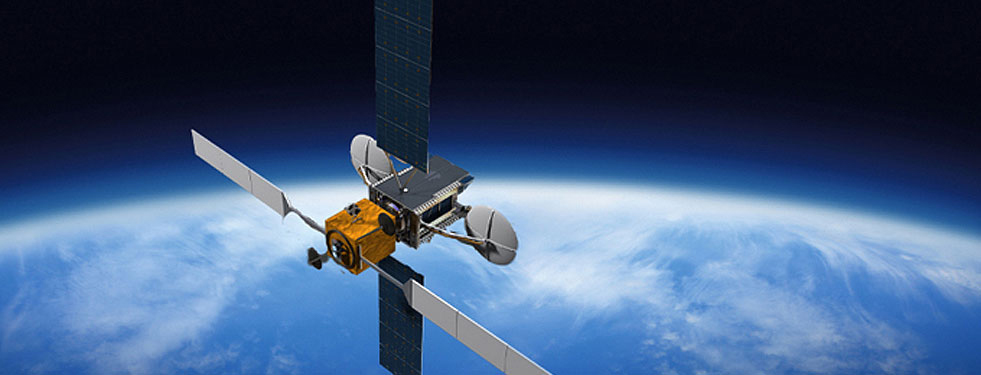Spacecraft Repair Droids Could Give Satellites Longer Lives

The ability to breathe new life into an aging satellite using robot mechanics could potentially boost satellite industry efficiency and reduce mission costs, and at least one aerospace firm is forging ahead with plans to do just that.
Now, all the company needs is customers.
"We're ready to sell, we're ready to build, we're ready to deliver," said Edward Horowitz, ViviSat's chairman of the board. ViviSat is a joint venture of rocket manufacturer Alliant Techsystems (ATK) and aerospace firm U.S. Space.
ViviSat's Mission Extension Vehicle (MEV) is being designed to dock to satellites in orbit, and then use its own thrusters to provide propulsion and attitude control. Among other functions, the spacecraft will be able to adjust an older satellite's orbit, rescue fully fueled satellites that may have launched into the wrong location, or move a satellite into a different orbit for a completely new purpose.
"Our target market is both commercial spacecraft as well as government spacecraft," Horowitz, told SPACE.com at the 28th National Space Symposium in mid-April. "If you just look at the commercial market, there are 350 to 360 satellites in geostationary orbit. Every year, 25 or so reach the end of their fuel life. Of that 25, we figure 10 are good target customers for this."
A repair droid for space
The MEV is being built by ATK, the company that manufactured the reusable solid rocket motors for NASA's now-retired space shuttles. Prototypes of the MEV's rendezvous and docking mechanisms are currently being tested at a special facility in Beltsville, Md. that simulates the microgravity environment of space. Horowitz declined to comment on the cost of the MEV program, but said that work on the spacecraft systems are continuing to evolve.
"We've really made a lot of progress," said Tom Wilson, vice president and general manager of ATK's space systems division. "The technology that we need exists off the shelf today, and most of it has been tested in orbit. For us, this reduces a huge amount of risk."
Get the Space.com Newsletter
Breaking space news, the latest updates on rocket launches, skywatching events and more!
The way that the MEV vehicle operates is also considered much less invasive than other similarly proposed projects, Horowitz said.
Since the MEV does not add fuel or remove any materials on the satellite itself, it is less intrusive. It also allows satellite operations to continue uninterrupted even with the MEV attached.
"Satellites were designed to not be tampered with, and this is a passive approach, which is appealing to operators," Horowitz said. "This enhances profitability because it allows operators to keep operating, so they keep their margins. It's no fuss, no muss and no mechanics."
"The economic environment has created a crisis," Horowitz said. "Change usually comes about in periods of crisis, and we have such a period now. This is a way of cost effectively maintaining perfectly good on-orbit assets. In this tight economic environment, logic says it would help. There's an opportunity for people to start looking at new things and new ways of doing things."
Satellite gas stations
And ViviSat is not the only company pursuing ways to extend the lives of satellites. Another example is Canada-based aerospace company MacDonald, Dettwiler and Associates Ltd. (MDA), which is designing a spacecraft that will effectively serve as an orbiting gas station and mechanic. [Video: How the Refueling Satellite Will Work]
This so-called Space Infrastructure Servicing vehicle will be able to refill a satellite's fuel tanks and perform minor repairs, as needed. The ambitious project has the potential to greatly improve how a commercial satellite company operates, but so far, MDA has struggled to lock in committed customers.
Satellite operator Intelsat initially agreed to pay $280 million over time for MDA's SIS vehicle to refuel certain satellites in its fleet. The first of these refueling missions was targeted to occur in 2015, but in January, both companies announced they have scrapped the agreement.
But ViviSat is confident it can attract enough customers to make a viable business case, which includes up to five docks and undocks per MEV, Wilson said. With much of the technology already in place, the development of the spacecraft could also be a faster and less risky process.
In fact, if a satellite operator purchases the service today, the first MEV spacecraft could be launched as early as 2015, Wilson said. But the trick is to find that first customer.
"I call it the penguin theory," Horowitz said, "You have all these people, all these potential customers, all these penguins standing on the ice, all creeping up to the edge. It's not until the first penguin goes in that the rest follow. So, we have the penguin theory, which is that someone's waiting for others to be first."
You can follow SPACE.com staff writer Denise Chow on Twitter @denisechow. Follow SPACE.com for the latest in space science and exploration news on Twitter @Spacedotcom and on Facebook.
Join our Space Forums to keep talking space on the latest missions, night sky and more! And if you have a news tip, correction or comment, let us know at: community@space.com.

Denise Chow is a former Space.com staff writer who then worked as assistant managing editor at Live Science before moving to NBC News as a science reporter, where she focuses on general science and climate change. She spent two years with Space.com, writing about rocket launches and covering NASA's final three space shuttle missions, before joining the Live Science team in 2013. A Canadian transplant, Denise has a bachelor's degree from the University of Toronto, and a master's degree in journalism from New York University. At NBC News, Denise covers general science and climate change.









